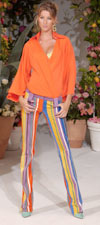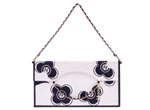| Shopping & Style |
 |
|||||
| |
|||||
| Sure, fashion seems like an indulgence right now, but it might just kick-start your enthusiasm for living in the city again. Here, a guide to the best of the coming spring 2002 season: all the key looks and how to wear them. | |||||
| BY MARK HOLGATE | |||||
But if the new world order was difficult for the front-row set
to digest, it was even tougher for the designers. In New York after
the tragedy, collections were shown, with little fanfare, to scattershot
— and shell-shocked — audiences. While many editors and
writers made it to Europe, there were only a handful of New York
store buyers in attendance. (A big round of applause, then, for
Kal Ruttenstein of Bloomingdale's, Julie Gilhart of Barneys, and
Anna Garner of Henri Bendel.) Plus, designers had to grapple with
a seemingly unanswerable question: Do people even care about fashion
these days? The designers conceived and created their collections
before September 11, but they can only be seen in a post-tragedy
framework. Given the difficulty of predicting the clothes-buying
public's mood — or the economy — it's hard to know what
will look appealing on store racks a few weeks from now, let alone
when spring comes around.
Over the next few pages is the best of spring: the trends, accessories, and must-have basics that — if the designers, retailers, and Mayor Giuliani get their way — you'll be rushing out to buy in a few months' time. There is, however, at least one purchase that's worth making right now. The CFDA/Vogue Fashion for America T-shirt, which went on sale last week at department stores and designer boutiques citywide, costs a mere $22.50, with the proceeds going to the Twin Towers Fund. It may not be the most expensive sartorial splurge you'll make in the coming months, but it will undoubtedly be the most meaningful. |
|||||
| See the looks of spring! | |||||
| From the November 12, 2001 issue of New York Magazine. | |||||
|
|
|||||
|
|
|||||

